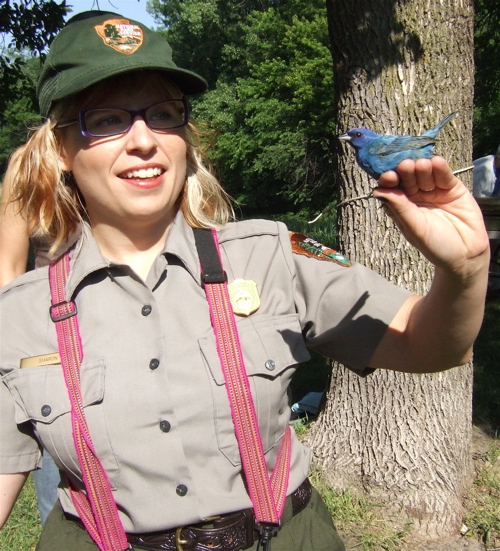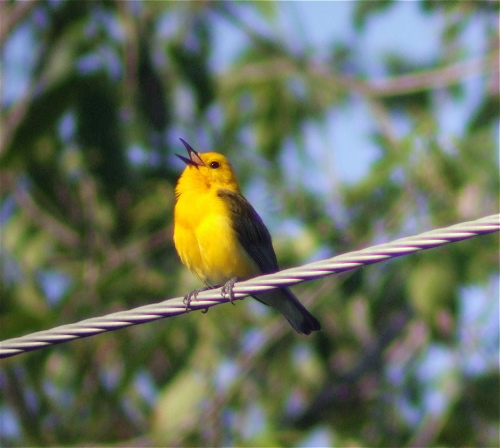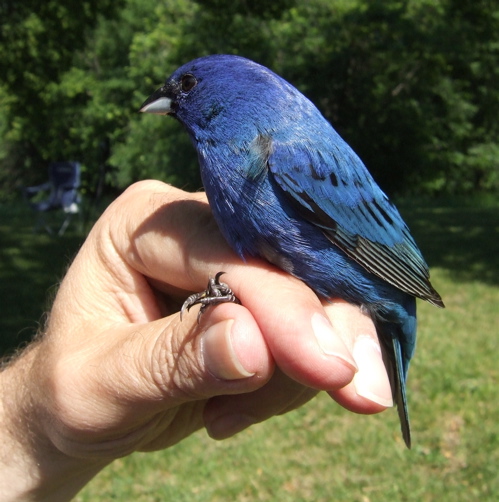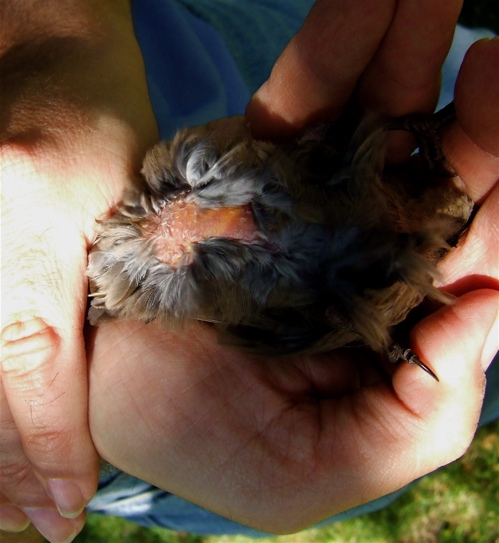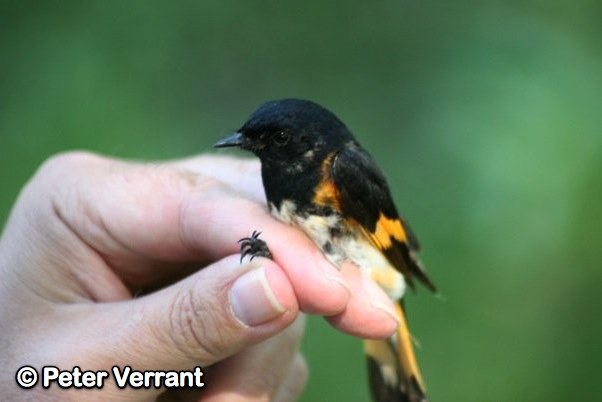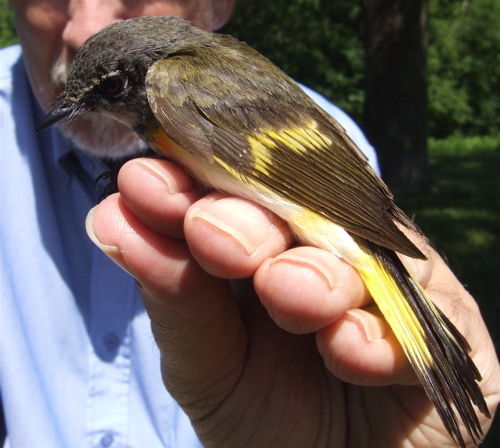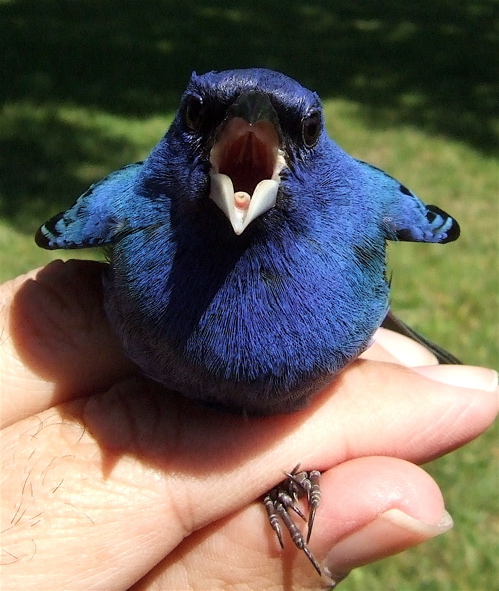 Watch out! It's the world's angriest indigo bunting!
Watch out! It's the world's angriest indigo bunting!
Last weekend's MN Bioblitz was great fun--if you don't know, a Bioblitz is an event where people try to document as many living species in a 24 hour period as they can: birds, fish, mammals, insects, plants, fungus, reptile--everything that is alive. I was sorry that I didn't get a chance to see some of the other non birding events, but the banding station ended up getting quite busy. I was so happy that Mark Newstrom volunteered his time to set up his nets so banding could be part o the day's activities.
We started with a morning bird walk around Crosby Park where we saw a ton of great birds, in particular, the above cedar waxwing (who is scratching his neck). Our small, but dedicated group on the walk was hoping for a prothonotary warbler...and we found a few. At first we heard what sounded to be two singing. I was anxious to try and get a photo since my only photo was the sad blue I got at the World Series of Bird last year. We listened to try and determine where the bird was, we were in a high traffic area and kept looking in the bushes. There were several birds perched and singin on the wire, one looked like a really bright goldfinch and then I realized...that was where the song was coming from. I aimed my scope and...
...Holy Crap! There's a male prothonotary warbler singing...out in the open...in perfect sun! Apparently, this guy did not get the memo that warblers are to skulk and hide and unlike children, they should be heard and most certainly not seen. He was so accommodating, I was able to get a video:
[youtube]http://www.youtube.com/watch?v=oUqJOKEj_-M[/youtube]
He's just one of the coolest warblers ever! Bright gold in front, delicate sky blue wings in the back! Did you notice that in the video he was kind enough to show both sides? Again, he must not be part of the official warbler union.
And the beauty did not end there, we ended up getting three male indigo buntings in the nets! Crosby Park is just loaded with buntings, they like to nest on the edge of woodlands and their active song is noticeable. I'm quite certain that one of the tree birds we got in was the bird that I digiscoped the other day at Crosby. One of the nets was near his territory and after we captured the buntings, we didn't hear him sing for awhile. He had to preen that greasy human touch off of his feathers.
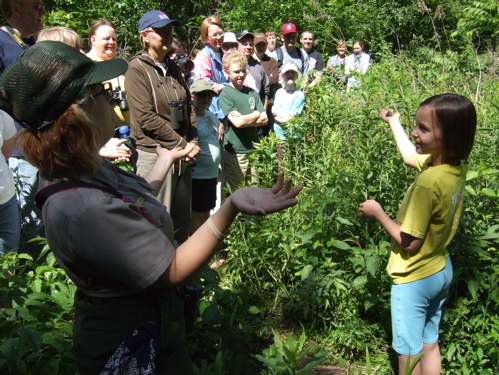 What a treat to be able to show a kid an indigo bunting up close. My favorite part is when it's time to let the bird go. If a kid is nearby, I look down and ask, "You want to release it?"
What a treat to be able to show a kid an indigo bunting up close. My favorite part is when it's time to let the bird go. If a kid is nearby, I look down and ask, "You want to release it?"
 Most kids say yes and all get a combination of glee and anxiousness in their face. When I placed the above male in that little girl's hands she gasped, "Oh! He's so soft!"
Most kids say yes and all get a combination of glee and anxiousness in their face. When I placed the above male in that little girl's hands she gasped, "Oh! He's so soft!"
Take that, nature deficit disorder!
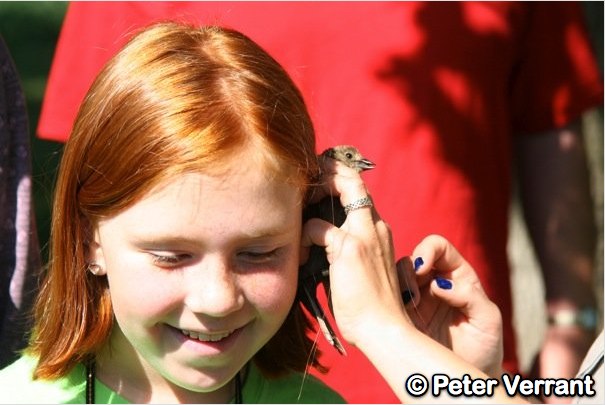 Another thing that is fun to do with kids (and frankly, adults) is when a larger bird comes in (like the above female cowbird) and put them up to their ears so they can hear the bird's heartbeat--it sounds like a cat purring. What a great way to open the conversation up to talk about a bird's metabolism and how much they eat and how they can survive in various temperatures.
Another thing that is fun to do with kids (and frankly, adults) is when a larger bird comes in (like the above female cowbird) and put them up to their ears so they can hear the bird's heartbeat--it sounds like a cat purring. What a great way to open the conversation up to talk about a bird's metabolism and how much they eat and how they can survive in various temperatures.
This cowbird hit the net the same time a female common yellowthroat did. I wondered if the cowbird had been about to make her move to the yellowthroat nest and deposit an egg. Mark blew on her feathers near her vent:
You could see the area was swollen and an egg beneath her transparent skin. Normally, when banding birds during nesting season, we release them near where they were trapped so they can go right back to the nest, but in the cowbird's case, we let her go in the opposite direction.
As we were about to wind up our banding station, we had three redstarts hit the nets. At first, we though we had two males (that's a male above) and one female. Males are kind of like mini orioles--small and orange black. Females are more grey and yellow.
The bird that I took out of the net and thought was female, ended up being a second year male. It takes redstarts two years to get their black and orange plumage. This bird was in transition. Still mostly in his immature plumage, but his tail feathers were already showing black. It was fun to show kids how you can sometimes get a very good idea of how old a bird is in hand.
I have to say that I have new respect for Crosby Park--even though it's in a very urban area, lots of great birds are there. We also heard both yellow-billed and black-billed cuckoos, broad-winged hawks, saw a beaver, someone else reported a river otter. It's a great place that I'll have to visit more often.

